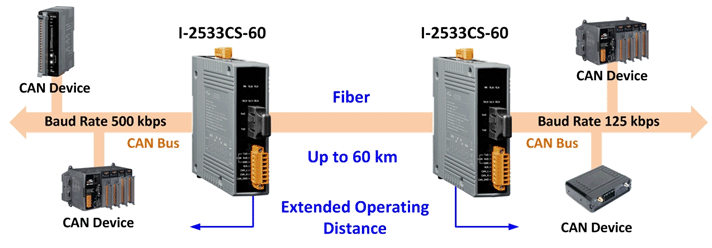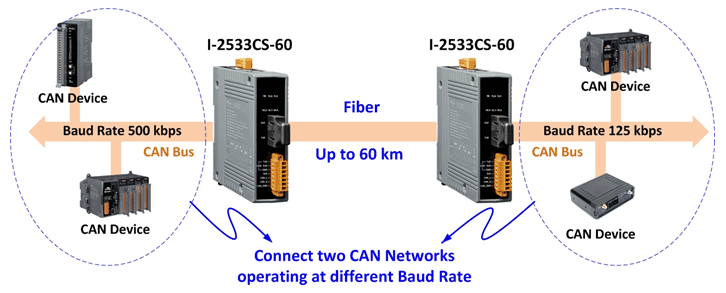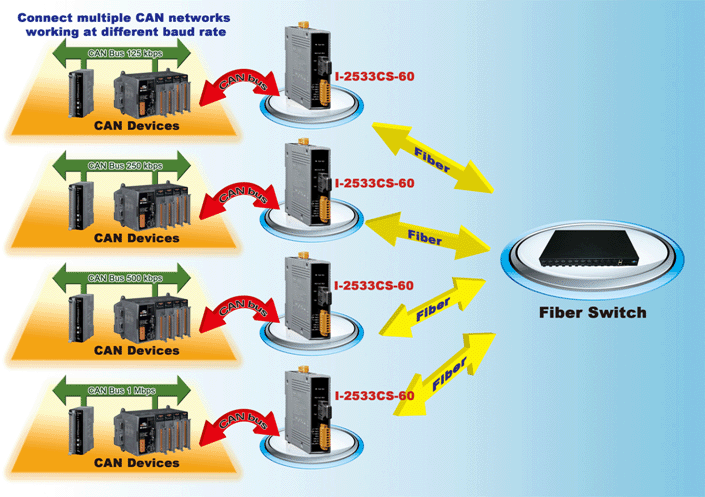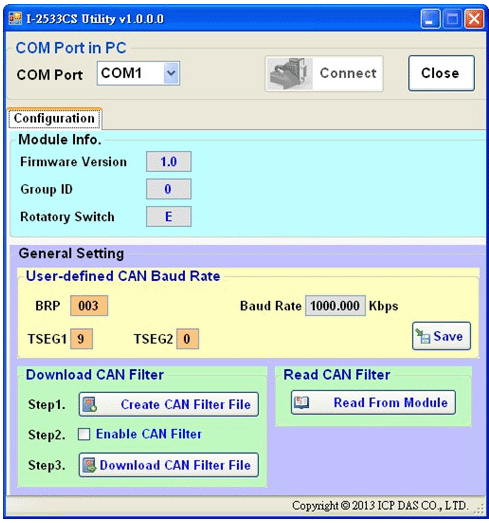I-2533CS-60 – CAN to Single Mode Fiber Bridge
New Products
2015-08-25
The I-2533CS-60 is a local CAN bridge used to establish a connection between two CAN bus systems via single mode fiber transmission medium. In order to solve the problem between CAN and fiber transmission mediums, the I-2533CS-60 is specially designed to convert the electrical CAN bus signal to optical signal, and the signal can be recovered to CAN bus by using another I-2533CS-60. Comparing with other CAN/Fiber converters, the I-2533CS-60 has three more important features. First, the transmission distance limitation of the CAN bus system will not be reduced due to higher CAN baud rate. No matter what kind of CAN baud rates you use, the data transmission distance of fiber can reach up to 60 km. It means that the total network working distance can be extended.

Second, the error on the CAN bus side of the I-2533CS-60 will not affect the general operation of the side on the fiber optic cable.

Finally, you can use different baud rate in the CAN networks at both ends of the fiber optical cable if necessary.

The main difference between I-2533 and I-2533CS-60 are the different type of fiber connectors and transmission distance. The I-2533CS-60 is designed for single mode fiber, and allow to extend CAN bus to maximum 60 km. Besides, the I-2533CS-60 provides group function which functions as basic message router. Users can decide the CAN message flows between several CAN bus systems.

The I-2533CS-60 provides an utility tool for user-defined baud rate and message filter configuration. When users use the I-2533CS-60 on two CAN networks which have different CAN baud rate, it may be useful to reduce the bus loading on the network.

Features:
- Fully compatible with the ISO 11898-2 standard
- Support both CAN 2.0A and CAN 2.0B
- NXP TJA1042 CAN transceiver
- 2500 Vrms isolation on the CAN side
- 3 kV galvanic isolation between the power supply and CAN channel
- Build-in switch to select 120Ω terminal resistor
- Rotary switch for CAN baud rate configuration
- Fiber Type: SC Duplex type ; Single mode ; 100 Base-FX
- Wave Length: 1310 nm
- Fiber Cable: 8.3/125, 8.7/125, 9/125 or 10/125 μm
- Transmission distance up to 60 km at any CAN baud rate
- Removable terminal block, Mount easily on DIN-rail
- Allow user-defined CAN baud rate
- Utility tool for CAN message filter configuration
- Support CANopen/DeviceNet/J1939… standard protocols which follows ISO 11898-2 specification.
Comparison Table of CAN to Fiber Products:
| Model Name | I-2533CS-60 | I-2533CS | I-2533CS-A *note1 |
I-2533CS-B *note1 |
I-2533 | I-2532 |
|---|---|---|---|---|---|---|
| CAN Interface | ||||||
| CAN Baud Range | 10 k to 1 M bps | 10 k to 500 k bps | ||||
| Fiber Interface | ||||||
| Fiber Mode | Single-mode | Multi-mode | ||||
| Connector | SC Duplex | SC | ST | |||
| Wavelength (nm) | 1310 | Tx: 1310 Rx: 1550 |
850 | |||
| Fiber Cable (μm) | 8.3/125, 8.7/125, 9/125 or 10/125 |
50/125, 62.5/125 or 100/140 |
62.5/125 | |||
| Propagation Delay | 190 μs *note2 | 250 μs *note2 | 125 ns @ any baud | |||
| Transmission Distance (km) | 60 | 30 | 15 | 2 | 1.4 | |
| Others | ||||||
| Extends CAN Bus Operating Distance | Yes | No | ||||
| Repeats CAN Bus signal | Yes | No | ||||
| Integrates two CAN Networks at different CAN Baud Rates |
Yes | No | ||||
| Allows CAN Message Filters | Yes | No | ||||
The I-2533CS-A and I-2533CS-B are a couple and must be used in pairs in CAN Bus applications.
*note2:
The propagation delay depends on the CAN Bus baud rate and the CAN message format. This value has been tested using a CAN baud rate of 1 Mbps, the CAN ID 0x1234567 and 8 bytes of data with a value of 0xFF.
For more information about the products described above, please refer to the following websites:
I-2533CS series: https://www.icpdas.com/en/product/guide+Industrial__Communication+Fieldbus__Communication+CAN__Bus#567

